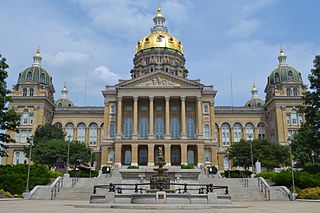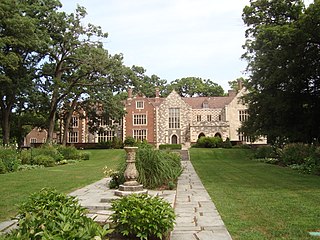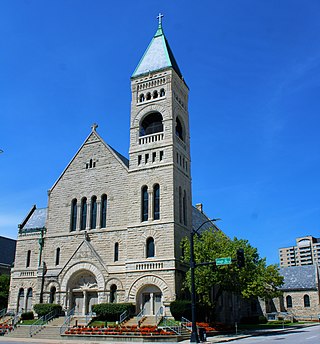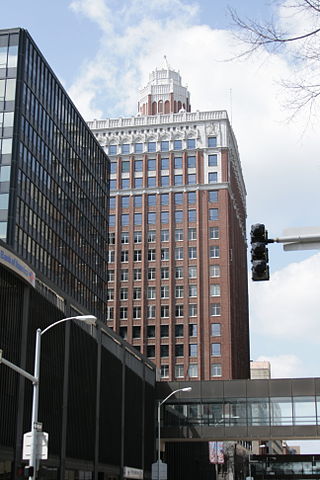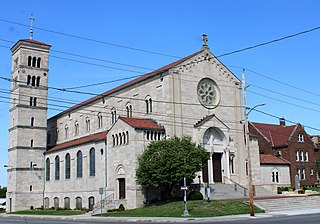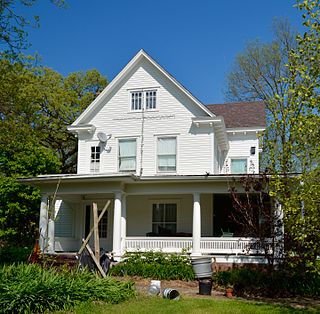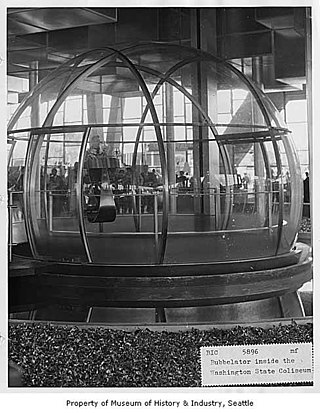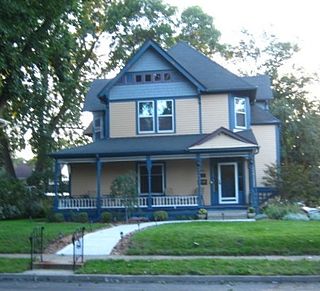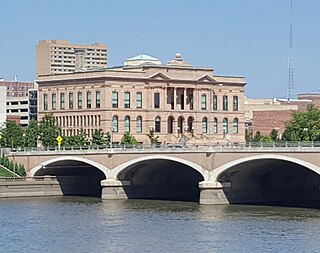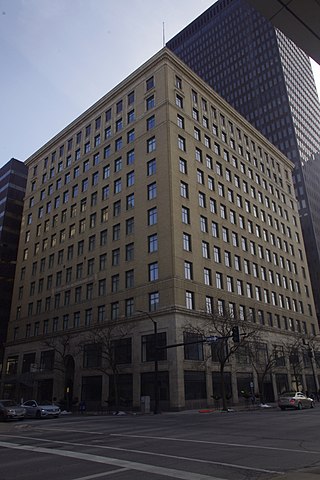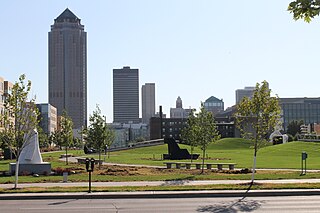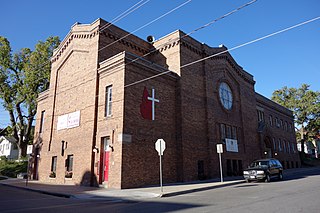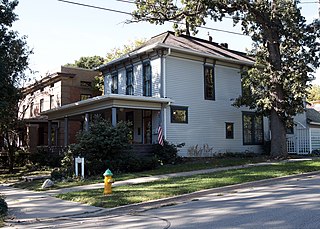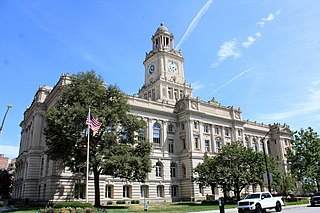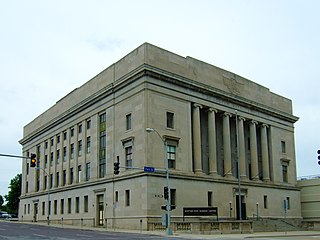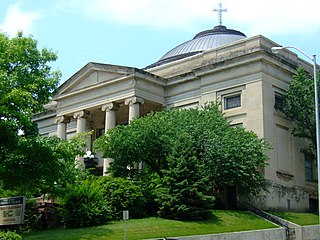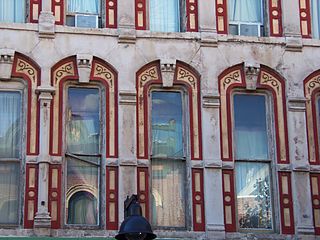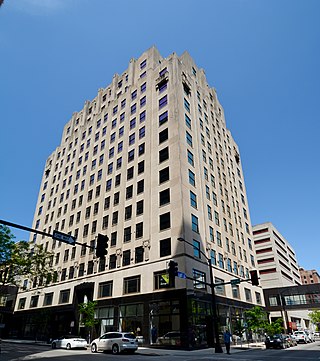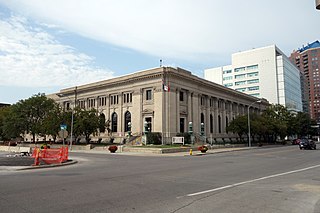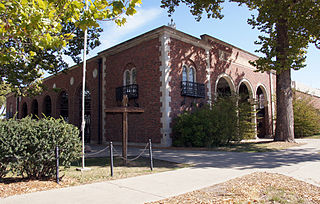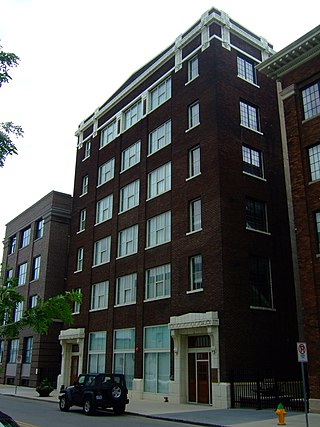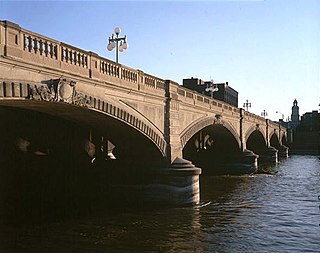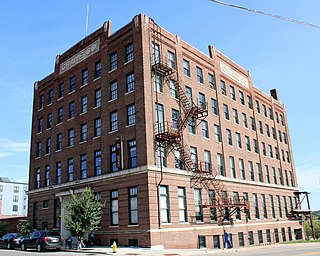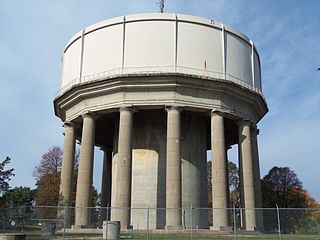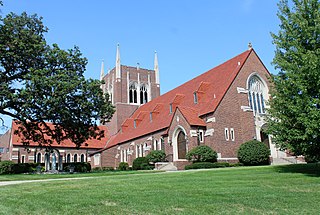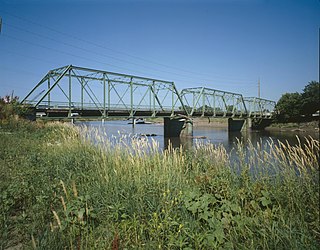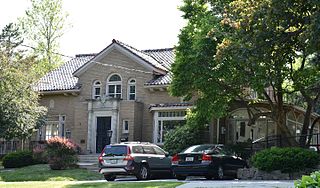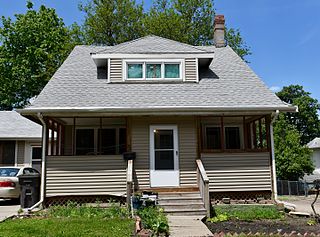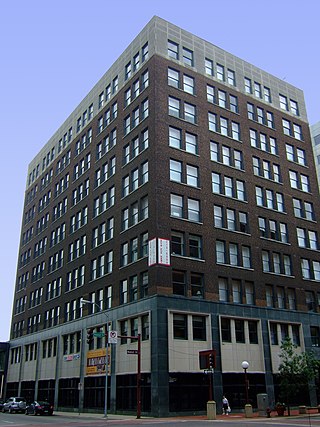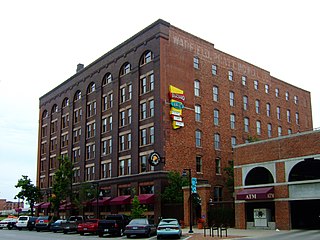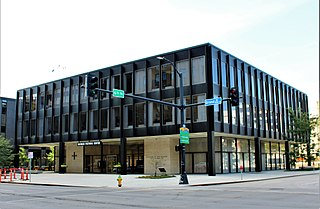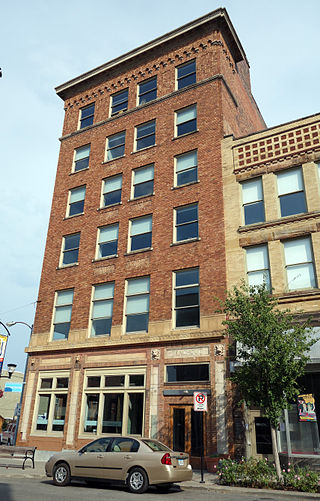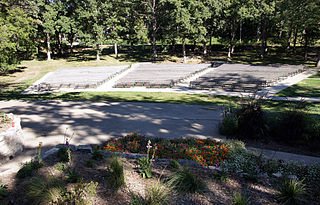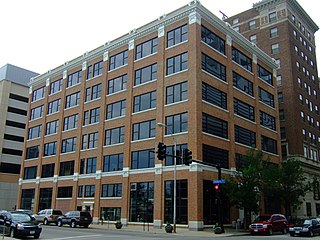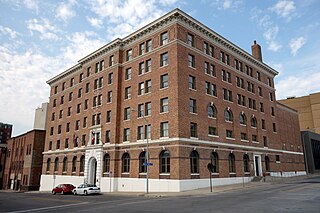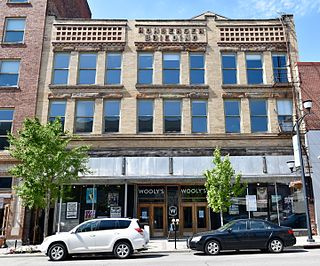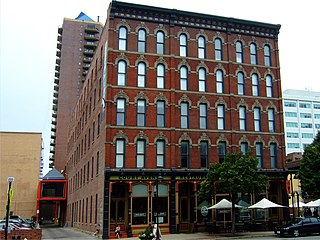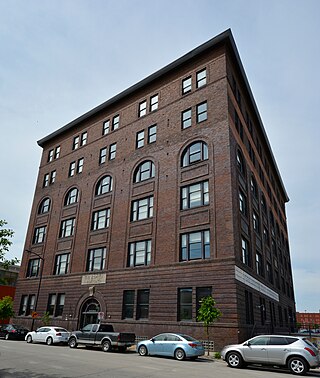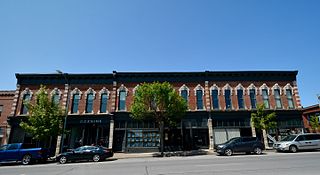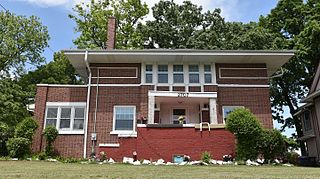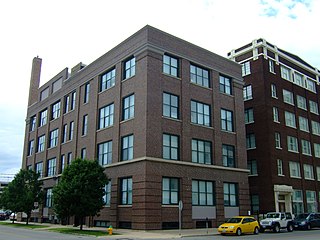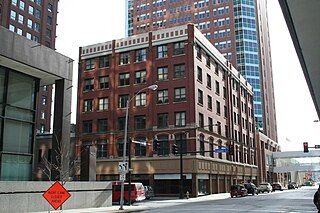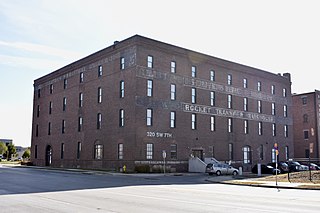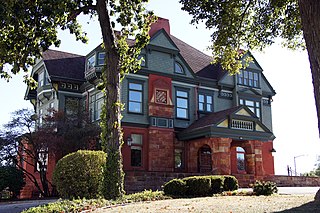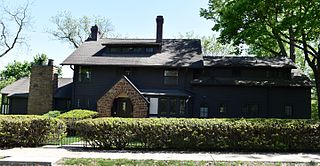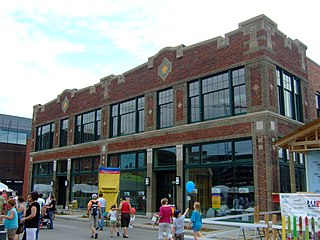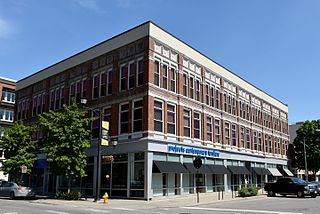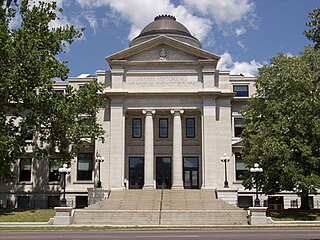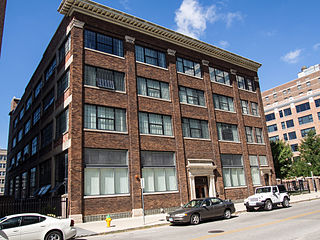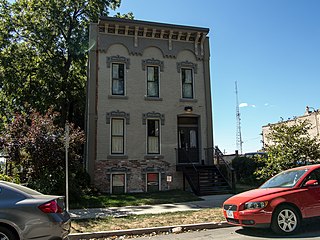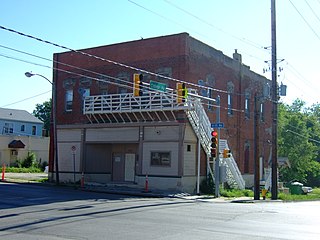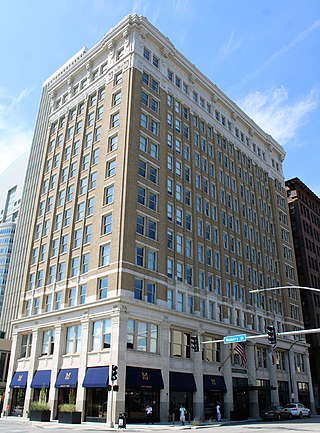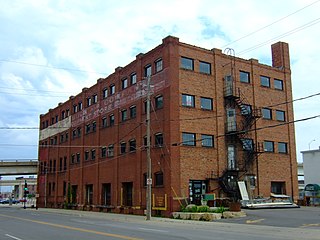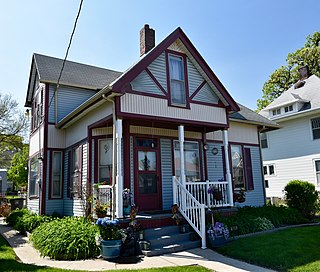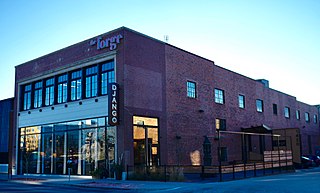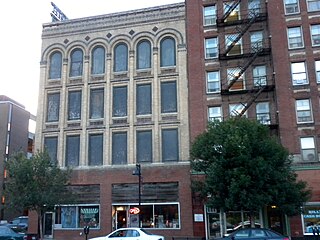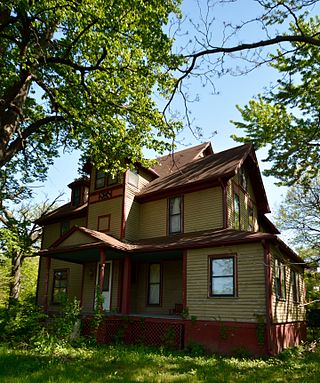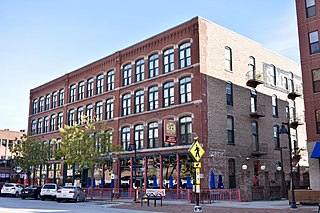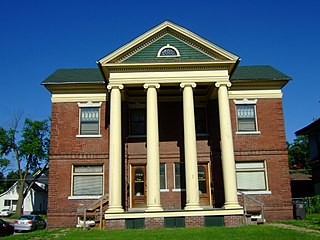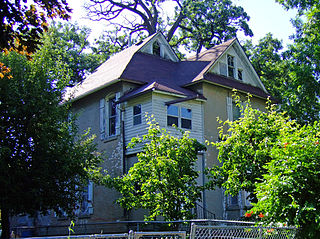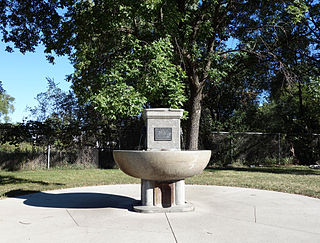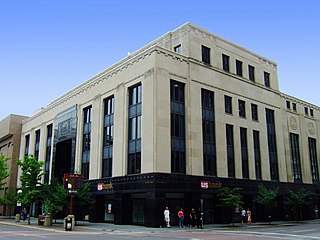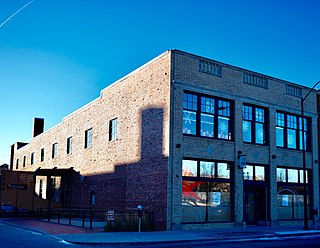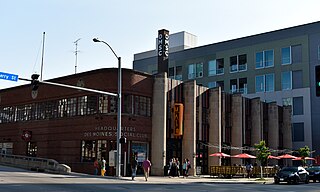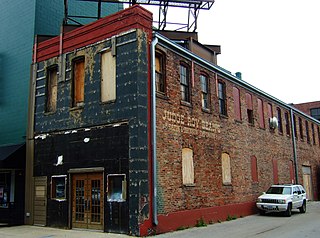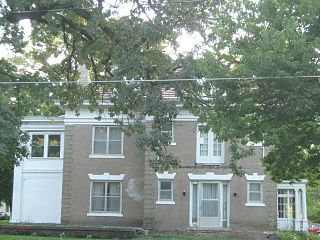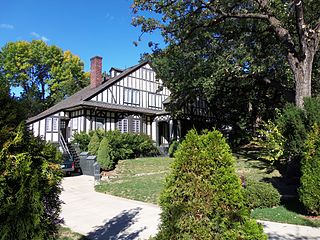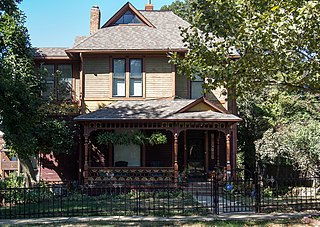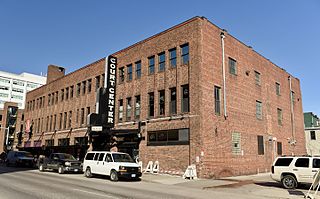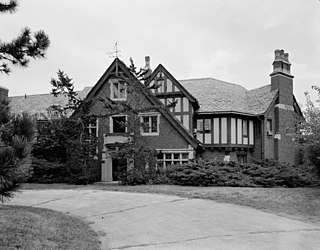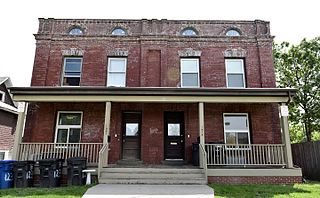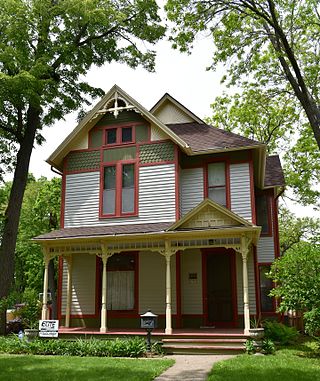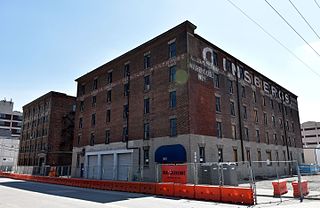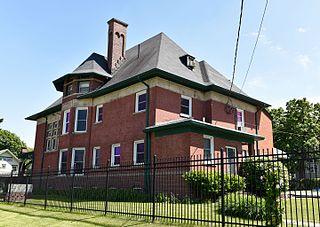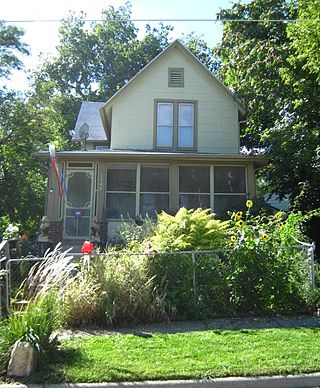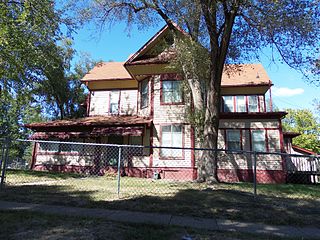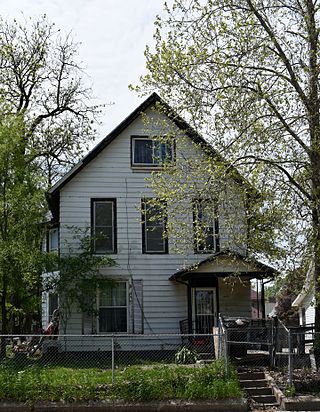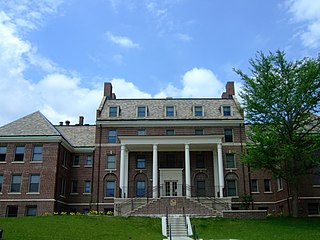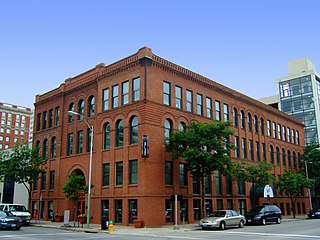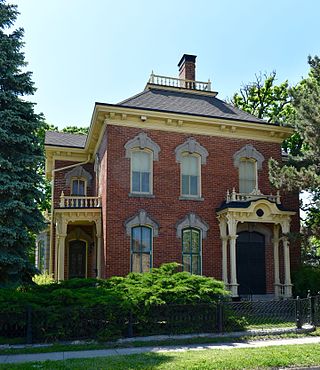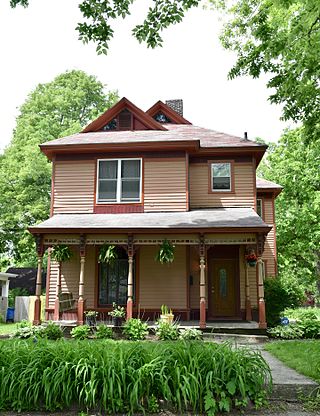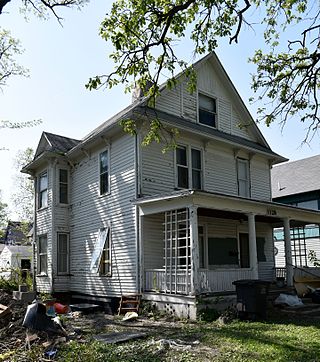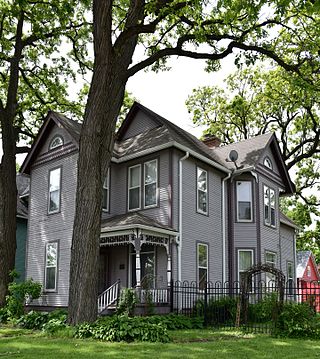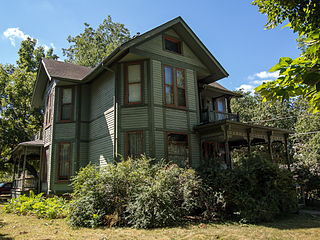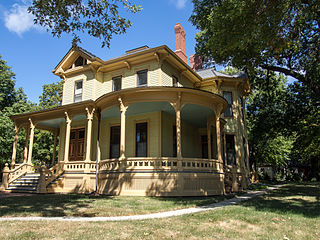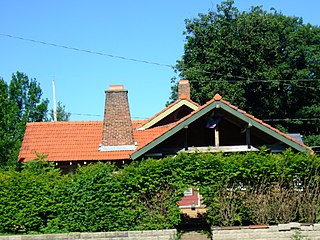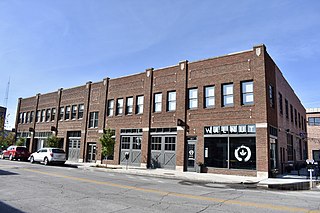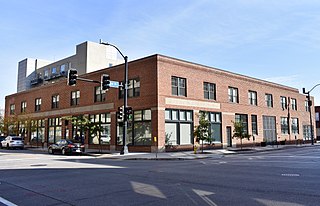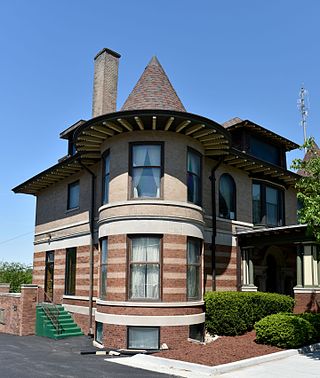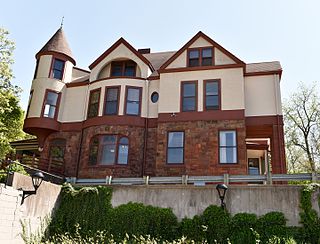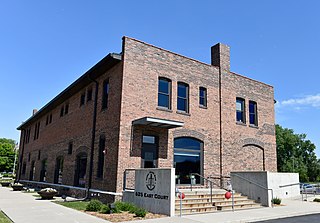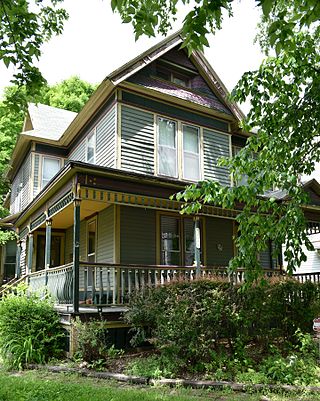100 Sights in Des Moines, United States (with Map and Images)
Legend
Welcome to your journey through the most beautiful sights in Des Moines, United States! Whether you want to discover the city's historical treasures or experience its modern highlights, you'll find everything your heart desires here. Be inspired by our selection and plan your unforgettable adventure in Des Moines. Dive into the diversity of this fascinating city and discover everything it has to offer.
Sightseeing Tours in Des Moines1. Iowa State Capitol
The Iowa State Capitol, commonly called the Iowa Statehouse, is in Iowa's capital city, Des Moines. As the seat of the Iowa General Assembly, the building houses the Iowa Senate, Iowa House of Representatives, the Office of the Governor, and the Offices of the Attorney General, Auditor, Treasurer, and Secretary of State. The building also includes a chamber for the Iowa Supreme Court, although court activities usually take place in the neighboring Iowa Supreme Court building. The building was constructed between 1871 and 1886, and is the only five-domed capitol in the country.
Wikipedia: Iowa State Capitol (EN), Website, Heritage Website
2. Terrace Hill
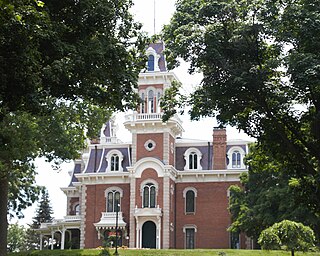
Terrace Hill, also known as Hubbell Mansion, Benjamin F. Allen House or the Iowa Governor's Mansion, is the official residence of the governor of Iowa, United States. Located at 2300 Grand Avenue in Des Moines, it is an example of Second Empire architecture. The home measures 18,000 square feet (1,600 m2). It sits on a hill overlooking downtown Des Moines, and has a 90-foot (27 m) tower that offers a commanding view of the city. The building's steeply pitched mansard roof, open verandas, long and narrow and frequently paired windows, and bracketed eaves give this house an irreplaceable design. The house was designated a National Historic Landmark in 2003.
3. Salisbury House
Salisbury House, in Des Moines, Iowa, is a Tudor, Gothic and Carolean style manor home built on a wooded hill with commanding views. It was built by cosmetics magnate Carl Weeks and his wife, Edith Van Slyke Weeks, between 1923 and 1928. Salisbury House was modeled after the King's House in Salisbury, England, contains 42 rooms and measures just over 22,000 square feet (2,000 m2). The property is owned and operated by the Salisbury House Foundation and is open to the public for tours, public events, and private rentals.
Wikipedia: Salisbury House (Des Moines, Iowa) (EN), Website, Heritage Website
4. Saint Ambrose Cathedral
St. Ambrose Cathedral is a historic building located in downtown Des Moines, Iowa, United States. It serves as a parish church and as the seat of the Diocese of Des Moines in the Catholic Church. The cathedral, along with the adjoining rectory, was listed on the National Register of Historic Places in 1979.
Wikipedia: St. Ambrose Cathedral (Des Moines, Iowa) (EN), Website, Heritage Website
5. Equitable Building
The Equitable Building is a high-rise located in Des Moines, Iowa. It is named after the insurance company Equitable of Iowa, which originally owned the building, and is located along Locust Street in the downtown area of the city. The 19-story Equitable Building, at 604 Locust St. in Des Moines, was completed in 1924, and standing at 318 ft (97m), for 49 years was the tallest building in Iowa. It remained the tallest building in Iowa until the completion of Financial Center in 1973. The Equitable Building is now the eighth tallest building in Iowa.
Wikipedia: Equitable Building (Des Moines) (EN), Heritage Website
6. Fort Des Moines Museum and Education Center
The Fort Des Moines Provisional Army Officer Training School was a military base and training facility on the south side of Des Moines, Iowa. Established in 1901, the base trained African American officers for the U.S. Army during World War I and was where women first began training for US Army service in 1942 as part of the Women's Army Corps. Surviving older portions of the base were declared a National Historic Landmark in 1974 in recognition of this history. The fort property was turned over to the city in the 1950s, and has since been put a number of public and private uses.
Wikipedia: Fort Des Moines Provisional Army Officer Training School (EN), Heritage Website
7. Basilica of Saint John
The Basilica of St. John is a Minor Basilica of the Catholic Church in the Drake neighborhood of Des Moines, Iowa, United States. It is also a parish church in the Diocese of Des Moines. The church building is listed on the National Register of Historic Places.
Wikipedia: Basilica of St. John (Des Moines, Iowa) (EN), Website, Heritage Website
8. Civic Center of Greater Des Moines
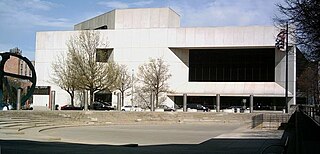
The Des Moines Civic Center is a 2,744-seat performing arts center belonging to Des Moines Performing Arts located in Des Moines, Iowa. It has been Iowa's largest theater since it opened on June 10, 1979, and is used for concerts, Broadway shows, ballets, and other special events.
9. Greek Orthodox Church of St. George
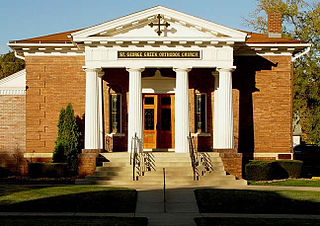
The Greek Orthodox Church of St. George in Des Moines, Iowa is a parish of the Greek Orthodox Archdiocese of America located in the Drake Neighborhood near Drake University. The building was listed on the National Register of Historic Places on February 28, 1997, as part of the architectural legacy of Proudfoot and Bird in Iowa.
Wikipedia: Greek Orthodox Church of St. George (Des Moines, Iowa) (EN), Heritage Website
10. James Sansom Carpenter House
The James Sansom Carpenter House was significant to Des Moines cultural history from 1906 to 1939. The 13 acre property named Oakwood estate by its owners J. S. Carpenter and his Spouse Florence L. Carpenter because of the old growth oak forestation. The Carpenters' collection was deemed by art critics as one of the finest collections of etchings and lithographs in America. The house held the Carpenter collection of 125 paintings and 350 etchings. J. S. Carpenter was also known as Sannie or Sandy after his oddly spelled middle name. J. S. Carpenter, a bridge building magnet, founded the Des Moines Association of Fine Arts in 1916. The Association members each contributed $100.00 annually for the purchase of paintings and sculptures. The members also received a 25% discount on art purchased at Association events. Carpenter was known as the Guru of fine arts by the Des Moines community. Visiting artists and dignitaries came to Des Moines to sell their art and often stayed with the Carpenter's at Oakwood. Carpenter was president of the Association from its inception until his death of heart disease in 1939. The Association transformed into the Edmundson Art Museum in 1940 under the auspices of Association Executive member, and Carpenter's close friend Jay N. (Ding) Darling. Darling as President of the Edmundson Art Foundation merged the original collection into the present day Des Moines Art Center.
Wikipedia: James Sansom Carpenter House (EN), Heritage Website
11. Bubbleator
The Bubbleator was a large, bubble-shaped hydraulic elevator with transparent acrylic glass walls operated from an elevated chair built for the 1962 World's Fair in Seattle. These transparent walls gave the illusion of looking through an actual 'soap bubble' by refracting light to obtain a rainbow-like effect for the riders inside. It was originally part of the Washington State Coliseum, where it lifted 100 passengers at a time up one floor through a structure of interlocking aluminum cubes to the "World of Tomorrow" exhibit. T. C. Howard of Synergetics, Inc. designed the Bubbleator and the exhibit. After the fair, the Bubbleator was relocated to the Center House at Seattle Center. By 1984, it had been removed and put in storage to make way for the Seattle Children's Museum. It was sold to a private owner in Des Moines, Washington, who recycled the upper part of the dome into a greenhouse. The control chair, which had also been in private hands, was donated to the Museum of History and Industry in 2005.
12. Dr. Anna E. and Andrew A. Johnstone House
The Dr. Anna E. and Andrew A. Johnstone House is a historic house in Des Moines, Iowa, United States. Built in 1887, the Queen Anne-style house was individually listed on the National Register of Historic Places in 1996. It was included as a contributing property in the Polk County Homestead and Trust Company Addition Historic District in 2016.
Wikipedia: Dr. Anna E. and Andrew A. Johnstone House (EN), Heritage Website
13. World Food Prize Hall of Laureates
The Old Downtown Des Moines Library is a historic building in downtown Des Moines, Iowa, United States that was built in 1903. It was individually listed on the National Register of Historic Places in 1977, and became a contributing property in the Civic Center Historic District in 1988. The building ceased to be a library in 2006 and now houses the Norman E. Borlaug | World Food Prize Hall of Laureates for the World Food Prize.
Wikipedia: Old Downtown Des Moines Library (EN), Website, Heritage Website
14. Liberty Building
The Liberty Building is a historic building located in downtown Des Moines, Iowa, United States. It has been a downtown landmark since 1923. The Liberty Building is located at the SW corner of 6th Avenue and Grand Avenue in the heart of downtown Des Moines. The building was originally home to Bankers Life Insurance & WHO (AM) Radio. Designed by the prominent Des Moines architectural firm of Proudfoot, Bird & Rawson, the 12-story building rises to a height of 174 feet (53 m).
Wikipedia: Liberty Building (Des Moines, Iowa) (EN), Heritage Website
15. John and Mary Pappajohn Sculpture Park
The John and Mary Pappajohn Sculpture Park is a 4.4-acre (1.8 ha) park within Western Gateway Park in Des Moines, Iowa. It opened in 2009 with 24 sculptures, with four more acquired later. The sculpture park is administered by the Des Moines Art Center and contains works by artists such as Louise Bourgeois, Jaume Plensa, Ai Weiwei, and Barry Flanagan. It is considered "one of the most significant collections of outdoor sculptures in the United States".
16. Trinity Las Americas United Methodist Church
Trinity United Methodist Church is located in Des Moines, Iowa, United States. It was listed on the National Register of Historic Places in 1998 as Trinity Methodist Episcopal Church, which was its previous name.
Wikipedia: Trinity United Methodist Church (Des Moines, Iowa) (EN), Heritage Website
17. Des Moines City Hall
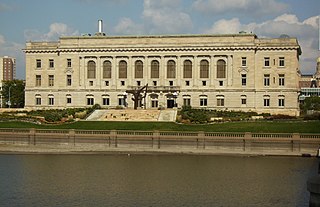
The Des Moines City Hall is a government building in Des Moines, Iowa, built in 1909 and 1910. It was individually listed on the National Register of Historic Places on November 10, 1977 as the Municipal Building, and became a contributing property in the Civic Center Historic District in 1988. The building serves as the seat for the government of the city of Des Moines. Beginning April 7, 2016, City Hall offices were temporarily relocated while the building underwent renovation. The construction was necessary to install modern heating, cooling, and sprinkler systems while preserving the historic character of the building. The project was expected to take 18–24 months. During that time, City Hall was closed to the public, and City offices moved to other nearby locations. Between February 26, 2018 and April 9, 2018, city offices moved back to City Hall.
18. Henry Wallace House
The Henry Wallace House is an historic building located in Des Moines, Iowa, United States. It was the home of Henry Wallace who was an advocate for agricultural improvement and reform. The house was listed on the National Register of Historic Places as a contributing property in the Sherman Hill Historic District in 1979 and it has been individually listed since 1993.
Wikipedia: Henry Wallace House (EN), Website, Heritage Website
19. Polk County Courthouse
The Polk County Courthouse located in Des Moines, Iowa, United States, was built in 1906. It was listed on the National Register of Historic Places in 1979 as a part of the County Courthouses in Iowa Thematic Resource. The courthouse is the third building the county has used for court functions and county administration.
Wikipedia: Polk County Courthouse (Iowa) (EN), Heritage Website
20. Scottish Rite Consistory Building
The Scottish Rite Consistory Building in Des Moines, Iowa was built during 1926–1927. It is a late date example of Neo-Classical style architecture, designed by Roland Harrison, a partner in the Des Moines architectural firm of Wetherell and Harrison.
Wikipedia: Scottish Rite Consistory Building (Des Moines, Iowa) (EN), Website, Heritage Website
21. First United Methodist Church
First United Methodist Church is located in downtown Des Moines, Iowa, United States. It has been listed on the National Register of Historic Places since 1984 as First Methodist Episcopal Church, which is its original name.
Wikipedia: First United Methodist Church (Des Moines, Iowa) (EN), Heritage Website
22. Youngerman Block
Youngerman Block is a three-story commercial building in downtown Des Moines, Iowa, incorporating Italianate architecture, with later alterations that introduced Art Deco detailing. Built in 1876, the Youngerman Block was designed by architect William Foster (1842-1909) for Conrad Youngerman.
23. Des Moines Building
The Des Moines Building is a historic building located in downtown Des Moines, Iowa, United States built in 1930 and based on the designs of the Des Moines architectural firm of Proudfoot, Rawson, Souers & Thomas. It is a combination of the Art deco and Art Moderne styles. The 14-story structure rises to a height of 190 feet (58 m). The former office building was abandoned and in May 2011 the city of Des Moines declared it a public nuisance so as to acquire it to be redeveloped. In November of the same year they sold the building for $150,000 to Des Moines Apartments, LP who developed it into 146 loft apartments. It was listed on the National Register of Historic Places in 2013. The basement has a fitness center, laundry room, storage, bicycle storage, and a community room. The rooftop is accessible via the 14th floor and has a great 360 degree view of Des Moines. The building is also connected to the city's extensive skywalk system.
24. Polk County Adminstration Building
The United States Post Office is a historic building located in Des Moines, Iowa, United States. It was individually listed on the National Register of Historic Places in 1974. It became a contributing property of the Civic Center Historic District when it was established in 1988. It now houses administrative offices for Polk County.
Wikipedia: United States Post Office (Des Moines, Iowa) (EN), Heritage Website
25. DNR Building
The Fish and Game Pavilion and Aquarium is located in the Iowa State Fairgrounds in Des Moines, Iowa, United States. The structure was erected with financial support from the State of Iowa. It was designed by the Des Moines architectural firm of Proudfoot, Rawson & Souers. It is a masonry building with a steel frame structural system and exhibits eclectic, Italian Renaissance detail. It was originally built from 1926 to 1927 and was expanded in 1929. The building was listed as a contributing property on the National Register of Historic Places in 1987 as a part of the Iowa State Fair and Exposition Grounds and it was individually listed in 1991 as a part of the Conservation Movement in Iowa MPS.
Wikipedia: Fish and Game Pavilion and Aquarium (EN), Heritage Website
26. Herring Motor Car Company Building
The Herring Motor Car Company Building, now known as 10th Street Lofts, is a historic building located in downtown Des Moines, Iowa. The building is a six-story brick structure rising 90 feet (27 m) tall. It was designed by the Des Moines architectural firm of Proudfoot, Bird & Rawson in the Classical Revival style. Clyde L. Herring had the building built in 1912 and it was completed the following year. It was originally a four-story building with two more floors added 18 months after it was originally built. By 1915, the company was building 32 Ford automobiles a day, and had delivered “more automobiles than any other one automobile agency in the United States.” Along with the neighboring Standard Glass and Paint Company Building, today it is part of the same loft apartment complex. The National Biscuit Company Building on the other side of the building has likewise been converted into an apartment building. It was listed on the National Register of Historic Places in 2004.
Wikipedia: Herring Motor Car Company Building (EN), Heritage Website
27. Court Avenue Bridge
The Court Avenue Bridge is a historic structure located in downtown Des Moines, Iowa, United States. It became a contributing property in the Civic Center Historic District in 1988, and was individually listed on the National Register of Historic Places on May 15, 1998 as a part of the Highway Bridges of Iowa MPS.
28. Crane Building
The Crane Building, also known as C.E. Erickson Co., in Des Moines, Iowa, United States. Crane Company was a plumbing and heating supplier and manufacturer that had this six-story manufacturing facility built in 1916. It was designed by the Des Moines architectural firm of Sawyer and Watrous. It is a utilitarian structure that is significant for its "thoughtful design" that utilizes elements of the Chicago School and a refined style. It was listed on the National Register of Historic Places in 2001. In 2013, the vacant building was renovated into 36 lofts targeted at artisans and costing 8 million dollars.
Wikipedia: Crane Building (Des Moines, Iowa) (EN), Heritage Website
29. Hazen Water Tower
The Allen Hazen Water Tower, also known as the Municipal Water Tower, is a historic structure located on the west side of Des Moines, Iowa, United States. It was listed on the National Register of Historic Places in 2004.
30. Saint Augustin Catholic Church
St. Augustin Catholic Church is a Catholic parish in the Diocese of Des Moines located on the west side of Des Moines, Iowa, United States. It was included as a contributing property in the Greenwood Park Plats Historic District and listed on the National Register of Historic Places in 2013.
Wikipedia: St. Augustin Catholic Church (Des Moines, Iowa) (EN), Url
31. Southwest Fifth Street Bridge
The Southwest Fifth St. Bridge is a historic structure located in downtown Des Moines, Iowa, United States. Built in 1898 after a controversy surrounding the bidding process, it is one of the last Pratt through truss bridges left in an urban setting in Iowa. The bridge was listed on the National Register of Historic Places in 1998 as a part of the Highway Bridges of Iowa MPS.
Wikipedia: Southwest Fifth St. Bridge (EN), Heritage Website
32. Thomas I. Stoner House
The Thomas I. Stoner House in Des Moines, Iowa, also known as The Highlands, was designed by Wetherell & Harrison and was built in 1931. It includes elements of Spanish Eclectic and Late 19th and 20th Century Revivals architecture. It overlooks the Waveland Golf Course and it has a ceramic tile roof.
33. Julius Scheibe Cottage
The Julius Scheibe Cottage at 815 College Ave. in Des Moines, Iowa, United States, was built in 1898. It was a work of architect George E. Hallett. It and the adjacent house split a corner land parcel and both faced south, while all other houses in the area faced the east or west ends of their parcels. The "parcelization of corner lots" this way increased density and the value of their real estate.
34. Hubbell Tower Condominiums
The Hubbell Building is a historic building located in downtown Des Moines, Iowa, United States. It was listed on the National Register of Historic Places in 2004. It has been featured on the Discovery Channel show Dirty Jobs.
Wikipedia: Hubbell Building (Des Moines, Iowa) (EN), Heritage Website
35. Warfield, Pratt and Howell Company Warehouse
The Warfield, Pratt and Howell Company Warehouse is a historic building located in downtown Des Moines, Iowa, United States. The building was built by wholesale grocer Warfield, Pratt and Howell Company. Wilson R. Warfield and John W. Howell moved their business to Des Moines in 1860 and moved to this location in 1884. William J. Pratt joined the partnership in 1897. The structure is a six-story commercial and office building that rises 93 feet (28 m) above the ground. The building was designed by Architect, Frank Crocker, and it is considered a good example of warehouse construction from the turn of the 20th century. It was completed in 1901 with an addition completed in 1909. It features load bearing brick piers, bearing walls, and wood column and girder technology on the interior. Other wholesale firms were housed in the building after 1935. It was part of a redeveloped district in the 1980s. The building was listed on the National Register of Historic Places in 1985.
Wikipedia: Warfield, Pratt and Howell Company Warehouse (EN), Heritage Website
36. Catholic Pastoral Center
The Home Federal Savings and Loan Association of Des Moines Building, also known as American Federal Savings and the Catholic Pastoral Center, is a historic building located in downtown Des Moines, Iowa, United States. Completed in 1962, it is considered to be "one of the most well-known examples of mid-century modern architecture in Des Moines."
Wikipedia: Home Federal Savings and Loan Association of Des Moines Building (EN)
37. Teachout Building
The Teachout Building is a historic building located in the East Village of Des Moines, Iowa, United States. It was individually listed on the National Register of Historic Places in 1999. In 2019 the building was included as a contributing property in the East Des Moines Commercial Historic District.
38. Sylvan Theater
The Sylvan Theater Historic District, also known as Greenwood Park Outdoor Theater, is located in Des Moines, Iowa, United States. It has been listed on the National Register of Historic Places since 1995.
Wikipedia: Sylvan Theater Historic District (EN), Website, Heritage Website
39. Clemens Automobile Company Building
The Clemens Automobile Company Building is a historic building located in downtown Des Moines, Iowa, United States. It was completed in 1916 as an "automotive department store" operated by the Clemens Automobile Company. They sold cars here that were produced by Willys-Overland Motors from 1916 to 1923. There was a claim that this was the largest building in the city that was devoted to automobiles. The first floor was used for the main sales room and offices, the second floor was used for used car sales and the service department, the fourth floor was used for a paint department, and the remaining three floors and the basement were used for storage. The Clemens family was involved in a variety of business enterprises and another one of their companies, the Standard Glass and Paint Company, was housed here from 1924 to 1979. The building was part of the Hotel Fort Des Moines until 2016, the two buildings were linked across the alley in 1985. The first and second floors housed Raccoon River Brewing Co. from May 1997 to March 2015. The building underwent a renovation in 2015 when it was converted to 44 apartments. At that time, the connection to the Hotel Fort Des Moines was sealed off. The first floor has been home to southern restaurant Bubba https://bubbadsm.com/ since July 2016.
Wikipedia: Clemens Automobile Company Building (EN), Heritage Website
40. Iowa Department of the Blind
The Iowa Commission for the Blind Building is a historic building located in downtown Des Moines, Iowa. The building is a steel-framed structure covered in brick. It is a nine-story state government office building that rises 95 feet (29 m) above the ground.
Wikipedia: Iowa Commission for the Blind Building (EN), Heritage Website
41. Hohberger Building
The Hohberger Building is a historic building located in the East Village of Des Moines, Iowa, United States. The building was built in 1895 and is one of the few remaining examples of a cast-iron column structure in the city. A dry goods store named Dockstader & Co. was the first retail establishment to occupy the building (1899–1915). The building stood empty for several years until it was renovated in 1999. The ground level of the building remains retail space and the upper floors are occupied by offices. It was individually listed on the National Register of Historic Places in 1978.In 2019 it was included as a contributing property in the East Des Moines Commercial Historic District.
42. Des Moines Saddlery Company Building
The Des Moines Saddlery Company Building is a historic building located in downtown Des Moines, Iowa, United States. It was built in 1881 by J. Rubelman of Muscatine, Iowa. He choose to move his operation to Des Moines because of its location on two rivers and the 13 railroads that served the city. It was one of four saddlery firms in a two block area. Rubelman's company made saddles, harnesses and leather works for 20 years. In the years since it has housed a shoe maker, rubber company, stove manufacturer, glove company, the Krispy Kone Company and the Kaplan Hat Company. The later was also the name of the restaurant that was located on the first floor.
Wikipedia: Des Moines Saddlery Company Building (EN), Heritage Website
43. Rumely Lofts
The Rumely–Des Moines Drug Company Building at 110 SW. Fourth St. in Des Moines, Iowa is a large brick warehouse block building. It is a work of architects Hallett & Rawson. It has also been known as the Rumely Bldg, as the Federal Machine Corp Bldg, and as the Security File Warehouse Building. It was listed on the National Register of Historic Places in 1989.
Wikipedia: Rumely–Des Moines Drug Company Building (EN), Heritage Website
44. Baker-Devotie-Hollingsworth Block
The Baker-Devotie-Hollingsworth Block is a historic building located in the East Village of Des Moines, Iowa, United States. The eastern two-thirds of the block was listed on the National Register of Historic Places in 1978 as the Studio Building. The western one-third was added to the National Register in 2008, and its name was changed at that time. In 2019 the entire building was included as a contributing property in the East Des Moines Commercial Historic District.
Wikipedia: Baker-Devotie-Hollingsworth Block (EN), Heritage Website
45. Mahnke House
The Mahnke House is an historical residential building located in Des Moines, Iowa, United States. The house was built by prolific Des Moines builder Fred W. Weitz in 1909 in the Prairie School style. The exterior is covered in Flemish bond brick veneer. It features a hip roof, a single-story west side solarium, a rear porch and a flat-roofed centered front portico with a raised entrance and square paned window lights. George and Emma Mahnke owned the house between 1909 and 1952 when they transferred the property to the Des Moines Annual Conference of the Methodist Church. The house then became the residence of the organization's superintendents. It was individually listed on the National Register of Historic Places in 1983, and it was included as a contributing property in the Ingersoll Place Plat Historic District in 2000.
46. National Biscuit Company Building
The National Biscuit Company Building, also known as National Biscuit Company Flats, is a historic building located in downtown Des Moines, Iowa, United States. The heavy timber and masonry building was built in 1906. Only half of the planned building was completed, and the north half of the property was later sold. It initially served as a production and distribution facility for the National Biscuit Company. Architect William F. Wilmouth, who designed the company's buildings is presumed to be the architect of this four-story Neoclassical building. Benson & Marxer served as the contractors. Des Moines was the third largest sales territory for the company. It was one of a few bakeries in the company that produced the Uneeda Biscuit, and it was one of three that produced a corn cracker in the mid-1920s.
Wikipedia: National Biscuit Company Building (Des Moines, Iowa) (EN), Heritage Website
47. Edna M. Griffin Building
The Flynn–Griffin Building, also known as the Flynn Block, Peoples' Savings Bank Building, and the Edna M. Griffin Building, is a historic building located in Des Moines, Iowa, United States. It was listed on the National Register of Historic Places in 2016.
48. Rocket Transfer Lofts
The Hawkeye Transfer Company Warehouse, also known as the Rocket Transfer Building, is a historic building located in downtown Des Moines, Iowa, United States. The building was built by Frederick Hubbell who founded F.M. Hubbell and Son, which became Hubbell Realty Co. The company has retained ownership of the building since it was built. Plans were approved in 2009 to convert the building, as well as the Schmitt and Henry Manufacturing Company complex, into loft apartments. It was listed on the National Register of Historic Places in 2010.
Wikipedia: Hawkeye Transfer Company Warehouse (EN), Heritage Website
49. Herndon Hall
Herndon Hall, also known as the Bergmann Mansion, is an historical residential building located in Des Moines, Iowa, United States. The house was built in 1881 in the Queen Anne style. It was designed by the Des Moines architectural firm of Foster & Liebbe for attorney Jefferson Polk. He named the house after his wife, Julia Herndon. Over the years it has been the home of three bishops of the Diocese of Des Moines, a clothing store, and it served as the National Headquarters for Better Homes & Gardens Real Estate Service. It now houses a cosmetic & reconstructive surgery practice It was listed on the National Register of Historic Places in 1977.
50. Jay Norwood and Genevieve Pendleton Darling House
The Jay Norwood and Genevieve Pendleton Darling House is a historic building located in Des Moines, Iowa, United States. The residence was the home of cartoonist Ding Darling, who worked for The Des Moines Register and whose cartoons were syndicated in over 100 newspapers across the country. In the early 1930s, he became involved in the conservation movement, especially wildlife conservation. His advocacy was reflected in his cartoons. Part of his conservation legacy in Iowa is the Cooperative Wildlife Research Unit program that he initiated at Iowa State College and the expansion of the research facilities at Iowa Lakeside Laboratory.
Wikipedia: Jay Norwood and Genevieve Pendleton Darling House (EN), Heritage Website
51. D.S. Chamberlain Building
The D.S. Chamberlain Building, also known as the L. W. Taylor Motor Company and Payne Motor Company Building, is a historic building located in Des Moines, Iowa, United States. The two-story brick structure was designed by the prominent Des Moines architectural firm of Proudfoot, Bird & Rawson. Completed in 1917, it features elongated Chicago-style windows on the upper floors and simple geometric details on the cornice level that reflect the Collegiate Gothic style. The building was built as a speculative venture by Davis S. Chamberlain, who was one of the founders of his family's drug manufacturing company. It is located in the city's "Motor Row" or "Auto Row" on the west side of downtown. In 1916 there were 111 motor related firms in Des Moines that was valued at $12 million in annual trade. Both the Taylor Motor Company and the Payne Motor Company were housed in the double storefront building for many years. Other car dealerships followed. The building was listed on the National Register of Historic Places in 2007.
52. Humphrey Center
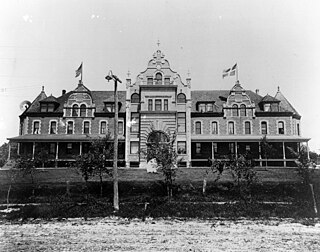
The Humphrey Center, also known as Old Main, is a historic building located on the campus of Grand View University in Des Moines, Iowa, United States. It was listed on the National Register of Historic Places in 1978.
53. Syndicate Block
The Syndicate Block, also known as the McCoy Building, is a historic building located in the East Village of Des Moines, Iowa, United States. It was individually listed on the National Register of Historic Places in 2001. In 2019 the building was included as a contributing property in the East Des Moines Commercial Historic District.
Wikipedia: Syndicate Block (Des Moines, Iowa) (EN), Heritage Website
54. Ola Babcock Miller Building
The Ola Babcock Miller Building, also known as the State Library of Iowa, is a historic building located in Des Moines, Iowa, United States. It was listed on the National Register of Historic Places in 1978 as the Iowa State Historical Building.
Wikipedia: Ola Babcock Miller Building (EN), Heritage Website
55. Standard Glass and Paint Company Building
The Standard Glass and Paint Company Building, also known as 10th Street Lofts, is a historic building located in downtown Des Moines, Iowa, United States. Ashton and Ross Clemens, who were brothers, had the building built in 1913 to house their company, which was said to be the largest glass and paint business west of Chicago. Local contractor J.E. Lovejoy was responsible for its construction. It was one of several warehouse buildings on the southwest corner of the downtown area. Established by the Clemens brothers, Standard Glass and Paint Company was in existence from 1903 to 1979. It was Des Moines' leading wholesale and retail supplier of a variety of building and remodeling supplies. The company remained in this building until the mid-1920s when they moved to the Clemens Automobile Company Building, which was owned by the same family. After it sat empty until 1931 various wholesale companies occupied this building over the succeeding years. Along with the neighboring Herring Motor Car Company Building it has been converted into loft apartments. It was listed on the National Register of Historic Places in 2004.
Wikipedia: Standard Glass and Paint Company Building (EN), Heritage Website
56. Henshie-Briggs Row House
The Henshie-Briggs Row House is a historic building located in Des Moines, Iowa, United States. While the row house was a popular building form in the 19th century in the city, there are very few examples that remain. The two-story, brick, Italianate structure was completed in 1883. The single-family dwelling features brick load-bearing walls, a flat roof, and a wooden cornice. The house was listed on the National Register of Historic Places in 2001. It was moved to its current location on Woodland Avenue in 2008.
57. Perry and Brainard Block
The Perry and Brainard Block, also known as the North Des Moines Town Hall, is a historic building located in Des Moines, Iowa, United States. The structure was built between 1888 and 1889 and the second floor served as the city hall for the suburb of North Des Moines. In the late 19th century Des Moines actively sought to annex its Victorian suburbs, with North Des Moines being the largest of these communities. This is the only known public building that has survived from the Annexation Movement era. The local government and community of North Des Moines debated annexation, not only of the municipalities, but of their schools as well. It was also the only community where the residents voted on the annexation issue, and this building also served as a polling place. The building served as the location of the celebration after the referendums passed in 1890. After its use as the city hall, the second floor became the lodge for the Ancient Order of United Workmen.
58. Midland Financial Building
The Hippee Building, also known as the Southern Surety Building, the Savings and Loan Building, and the Midland Building, is a historic building located in downtown Des Moines, Iowa, United States. It was completed in 1913 by George B. Hippee whose father, George M. Hippee, was one of the first merchants in Des Moines. George B. developed the first interurban railway in the city and it connected Des Moines to other communities in central Iowa. The 172-foot (52 m), 12-story structure was designed by the Des Moines architectural firm of Sawyer and Watrous in the Early Commercial style. At the time of it completion, the building was Iowa's tallest skyscraper. It was used as an office building until the Aparium Hotel Group of Chicago acquired it in 2017 and began converting the building into a 138-room hotel. It was listed on the National Register of Historic Places in 2018.
59. Grocers Wholesale Company Building
The Grocers Wholesale Company Building, also known as the Sears and Roebuck Farm Store, is a historic building located in Des Moines, Iowa, United States. Completed in 1916, this was the first of four warehouses built and owned by Iowa's only and most successful statewide cooperative grocery warehouse. It is possible that it was the first statewide organization of this kind in the country. The cooperative allowed independent grocers to compete against chain stores and survive wholesale grocers' surcharges. They leased their first warehouse after they organized in 1912. Each successive time the cooperative built a new warehouse it was larger and technologically more advanced than the previous one. This particular cooperative grew to include parts of four states: Iowa, southern Minnesota, northern Missouri and eastern Nebraska. They built their second warehouse in 1930 and moved out of this facility. They continued to own this building until 1968, and they leased it out to other firms. The Sears Farm Equipment Store began to occupy the building in 1937 and continued here until 1959. The cooperative became the Associated Grocers of Iowa in the late 1950s, and it continued in existence until 1985. The building was listed on the National Register of Historic Places in 2008.
Wikipedia: Grocers Wholesale Company Building (EN), Heritage Website
60. William A. and Etta Baum Cottage
The William A. and Etta Baum Cottage is a historic building located in Des Moines, Iowa, United States. Built in 1891, the 1½-story structure features a gable-end facade, brick foundation, and a small front porch with a gable-end roof. It is considered a good example of the gable-on-hip subtype of the Queen Anne cottage. There were only a few that were built with 1½-stories as most were two-stories. Its significance is based on how it demonstrates that a modest-sized dwelling can embrace the picturesque design. The cottage was individually listed on the National Register of Historic Places in 1996. It was included as a contributing property in the Polk County Homestead and Trust Company Addition Historic District in 2016.
Wikipedia: William A. and Etta Baum Cottage (EN), Heritage Website
61. Apperson Iowa Motor Car Company Building
The Apperson Iowa Motor Car Company Building, also known as the Garage Building for Rawson Brothers, is a historic building located in Des Moines, Iowa, United States. It is significant for its association with the prominent Des Moines architectural firm that designed it, Proudfoot, Bird & Rawson. Completed in 1921, it was designed and built within the period of time the firm was at its most prolific (1910–1925). It is also significant for its association with the rise of the Automobile Industry in the city. Auto dealerships and distributorships leased the building from 1921 to 1951. Architect Harry D. Rawson and his brothers owned the building from 1921 to 1938. The two-story structure is located on a midblock lot in the midst of what was the automobile sales, service, and manufacturing district on the western edge of the downtown area. The first floor housed a showroom in the front with offices on a mezzanine. The back of the first floor and the second floor was used for assembling and servicing automobiles. The building was listed on the National Register of Historic Places in 2016.
Wikipedia: Apperson Iowa Motor Car Company Building (EN), Heritage Website
62. Earle & LeBosquet Block
The Earle & LeBosquet Block, also known as the Redhead & Wellslager Block, is a historic building located in Des Moines, Iowa, United States. Completed in 1896, the building is a fine example of the work of Des Moines architect Charles E. Eastman. It shows Eastman's ability to use Neoclassical forms and integrate the more modern Chicago Commercial style. It is also an early use of terra cotta for architectural detailing and buff-colored brick for the main facade in Des Moines, which became widespread in the city in the following decades. The main floor housed two commercial spaces and the upper floors were used for warehouse space. The four-story structure was built by local contractor Gerrit Van Ginkel, and it was owned by attorneys Ira M. Earle and Peter S. LeBosquet. It replaced a three-story brick building that was built at this location in 1876. The building was listed on the National Register of Historic Places in 2009.
63. Chaffee-Hunter House
The Chaffee-Hunter House is a historic building located in Des Moines, Iowa, United States. Built in 1886, the single family dwelling is named for its first two residents, Henry L. Chaffee and Edward H. Hunter who bought it from Chaffee in 1891. The house calls attention to Hunter who served as the local postmaster from 1894 to 1898. He conceived and implemented the idea of a streetcar-mounted collection box for the mail. It was later implemented in other cities in the country. The 2½-story frame Queen Anne structure features a gable-on-hip roof with intersecting gables, a brick foundation, wrap-around porch, and dormer windows. The house was individually listed on the National Register of Historic Places in 1998. It was included as a contributing property in the Polk County Homestead and Trust Company Addition Historic District in 2016.
64. Seth Richards Commercial Block
The Seth Richards Commercial Block, also known as the Lederer-Strauss Building, is a historic building located in downtown Des Moines, Iowa, United States. Its construction represents the transition of Court Avenue from a retail center to the city's wholesale district.
Wikipedia: Seth Richards Commercial Block (EN), Heritage Website
65. The Manor
The C.H. Baker Double House, also known as the Indiana Apartments, The Manor, and The Manor House, is an historic building located in Des Moines, Iowa, United States. Built from 1901 to 1902, it is a two-story structure that features balloon frame construction with brick veneer. It was designed in the Colonial Revival style by the Des Moines architectural firm of Smith & Gutterson. Its significance is attributed to its location on the Sixth Avenue streetcar route "to capitalize on the appeal of public transportation." It was one of the first multiple-family rental properties along the avenue, and it was built for upper-middle class occupancy. It was part of the movement toward denser residential use in this area of the city. The house was listed on the National Register of Historic Places in 1996.
66. Lowry W. and Hattie N. Goode First North Des Moines House
The Lowry W. and Hattie N. Goode First North Des Moines House, also known as the Allabach House, is a historic building located in Des Moines, Iowa, United States. The Late Victorian-style single-family dwelling is significant for its association with Lowry W. Goode. Goode was a prominent real estate developer in the Des Moines area in the 19th century. Built c. 1884 in what was the suburb of North Des Moines, this house is one of the last resources that calls attention to his work. The Goode's themselves built and occupied several houses in North Des Moines, and they lived here for about one year after it was built. They then used it as a rental property for a while until they sold it. The two-story brick structure features a main block with a rectangular plan, intersecting gables, a single-story bay window on the west elevation, a two-story extension on the south elevation, and a rear wing. The original porch has been removed. The house was individually listed on the National Register of Historic Places in 1998. It was included as a contributing property in the Polk County Homestead and Trust Company Addition Historic District in 2016.
Wikipedia: Lowry W. and Hattie N. Goode First North Des Moines House (EN), Heritage Website
67. Southeast Water Trough
The Southeast Water Trough is a historic structure located in Des Moines, Iowa, United States. It is one of the last of 15 National Humane Alliance fountains that were placed around the city by the Iowa Humane Alliance. They were also named Ensign fountains after the founder of the National Humane Alliance, Hermon Lee Ensign. This was one of two placed in Des Moines in 1906.
68. U.S. Bank
The Iowa-Des Moines National Bank Building, also known as the Valley National Bank Building and U.S. Bank, is a historic building located in downtown Des Moines, Iowa, United States. Designed by the prominent Des Moines architectural firm of Proudfoot, Rawson, Souers & Thomas, it was designed to be a 21- or 22-story building. It is one of the few downtown commercial buildings built in the Art Deco style. It is also thought to be one of the first bank buildings to put the banking room on the second floor while placing retail space on the first floor. Given its location in an area dominated by retail this made sense. This location had a bank on it since 1882 when the Des Moines National Bank built here. The present building was the result when Des Moines National Bank merged with Iowa National Bank and Des Moines Savings Bank and Trust Company in 1929. The original design for the building was a five-story base and a set-back rental office tower on top of it. The base was begun in 1931 and completed a year later. The building is composed of black polished granite on the first floor and the upper floors are Bedford stone. There is a recessed entrance in the center bay of the main facade. The fifth floor was meant to be the base of the office tower that was never built.
Wikipedia: Iowa-Des Moines National Bank Building (EN), Heritage Website
69. Register and Tribune Building
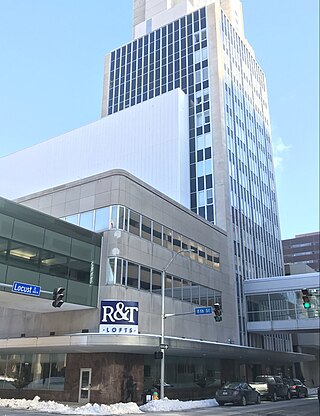
The Register and Tribune Building is a historic commercial building at 715 Locust Street in Des Moines, Iowa. Built in 1918, it served as home to The Des Moines Register, one of Iowa's leading newspapers, until about 2000, when the presses were moved to another building, and 2013, when the Register's owner, the Gannett Corporation, moved out in 2013. It was designed by one of Iowa's leading architectural firms, Proudfoot, Bird and Rawson, with later additions by equally prominent firms.
Wikipedia: Register and Tribune Building (EN), Heritage Website
70. G.W. Jones Building
The G.W. Jones Building, also known as the Electric Farm Lighting Co. and the Laster Motor Company, is a historic building located in Des Moines, Iowa, United States. It is significant for its association with the rise of the automobile industry in the city. George W. Jones was a pioneering Des Moines auto dealer and Delco-Light generator distributor who occupied the building from 1920 to 1922. In this building he sold generators and appliances that were manufactured by General Motors, and they were sold by regional distributor-dealers in a similar fashion to automobiles. Jones continued to own the building until 1943 and he leased it to other automobile-related businesses. It is also significant for its association with the prominent Des Moines architectural firm that designed it, Proudfoot, Bird & Rawson. Completed in 1920, it was designed and built within the period of time the firm was at its most prolific (1910-1925). Local contractor A.H. Neumann built the two-story brick structure. It features a symmetrical facade, large square window openings, restrained Neoclassical details, and parapet walls. The building was listed on the National Register of Historic Places in 2016.
71. Des Moines Social Club
The Des Moines Fire Department Headquarters' Fire Station No. 1 and Shop Building are historic buildings located in downtown Des Moines, Iowa, United States. Completed in 1937, the facility provided a unified campus for the fire department's administration, citywide dispatch, training, maintenance, as well as the increased need for fire protective services in the commercial and warehouse districts in which the complex is located. It was designed by the Des Moines architectural firm of Proudfoot, Rawson, Brooks and Borg, and built by local contractor F.B. Dickinson & Co. The project provided jobs for local residents during the Great Depression, and 45% of its funding was provided by the Public Works Administration (PWA). The City of Des Moines provided the rest of the funds. The radio tower, which shares the historic designation with the building, was used to dispatch fire personnel from 1958 to 1978. The buildings were used by the local fire department from 1937 to 2013. It was replaced by two different facilities. The old fire station and shop building was acquired by the Des Moines Social Club, a nonprofit arts organization.
Wikipedia: Des Moines Fire Department Headquarters (EN), Heritage Website
72. Boyt Company Building
The Boyt Company Building, also known as the Gilchrist Building, is a historic building located in Des Moines, Iowa, United States. The significance of this two-story brick structure is its association with the Boyt Company. Boyt manufactured leather goods in this building from 1904, when it was built, until 1908. They moved to a now nonextant building to the west at that time. From 1943 to 1945 Boyt was a contractor with the United States Armed Forces, and they leased this building as a depot for shipping supplies. They supplied leather and canvas goods to the Marine Corps, the Navy Department, Signal Corps, Rock Island Arsenal and Ordnance Department, the Army Air Force, and the Treasury Department, among others.
73. George B. Peak House
The George B. Peak House, also known as New Life Eternity House, is a historic building located in Des Moines, Iowa, United States. It is a 2½-story brick dwelling that features a hipped roof with a flat deck, pedimented dormers, and a portico with freestanding columns. It was built for George M. Peak who came to Des Moines in 1888 from Kentucky. He worked as the local manager of the Equitable Life Assurance Society of the U.S. before he organized the Central Life Assurance Society of the U.S. in 1896. He served as president of the later until his death. He also promoted the Insurance Exchange building in Des Moines, and advocated for the construction of Keosauqua Way. After Peak died in 1923 the house was acquired for use as a fraternity and then a sorority house for Drake University. It has since been converted into a multi-family dwelling. The house was listed on the National Register of Historic Places in 1978.
74. Byron and Ivan Boyd House
The Byron and Ivan Boyd House, also known as Boyd Cottage, is a historic building located in Des Moines, Iowa, United States. Built in 1924, the 2½-story Tudor Revival half-timbered cottage is located in an up-scale neighborhood. The neighborhood is composed of large private residential lots with numerous mansions built in the first half of the 20th century for the city's prominent citizens. Its significance is its association with Byron Bennett Boyd. He was a local architect, and a nationally recognized artist and painter. Boyd was the architect that designed this house, and lived here from 1924 to 1945. He began practicing architecture at the prominent Des Moines firm of Proudfoot, Bird and Rawson before setting up his own practice in 1916 with Herbert Moore. His work includes Salisbury House (1923), Fred W. Hubbell mansion, known as Helfred Farms (1928), and the Ralph Rollins House (1926). Boyd's wife, Ivan Bloom Hardin, owned her own publishing company.
75. Dr. John B. and Anna M. Hatton House
The Dr. John B. and Anna M. Hatton House is a historic building located in Des Moines, Iowa, United States. The house is significant for its suburban architecture in the former suburb of North Des Moines, especially the canted bay subtype of the Stick Style with Italianate influence. This 2½-story frame structure on a brick foundation features a hip roof with intersecting gables, a canted bay tower on the southeast corner, porches on the front and side, and a two-story bay window on the south elevation. The house was individually listed on the National Register of Historic Places in 1998. It was included as a contributing property in the Polk County Homestead and Trust Company Addition Historic District in 2016.
Wikipedia: Dr. John B. and Anna M. Hatton House (EN), Heritage Website
76. F.A. Benham House
The F.A. Benham House, also known as the Stoner House and the Barquist House, is a historic building located in Des Moines, Iowa, United States. Built in 1884, the two-story structure features wood-frame construction, a brick foundation, and decorative details that were influenced by the Stick Style of architecture. Its significance is found in its late Victorian design that is exemplified in the Eastlake style. It can be seen in the building's massing, roof's steep pitch, and front porch's spindlework. The house was listed on the National Register of Historic Places in 1998. The house shares the historic designation with the frame barn and the Victorian cast iron fence and gate that runs in front of the house.
77. Court Center
The Taft–West Warehouse, also known as the C.C. Taft Company Building, Plumb Supply Company, Ben's Furniture Warehouse, and Nacho Mamma's, is a historic building located in Des Moines, Iowa, United States. Completed in 1923, this three-story brick structure was built during a transitional period between the dominance of railroads the emergence of trucks servicing warehouses. It was designed by local architectural firm of Vorse, Kraetsch, & Kraetsch. It features cleans lines of the Commercial style as opposed to the fussiness of late Victorian styling that was dominant in a great deal of the city's commercial architecture. The building was also located in the Court Avenue wholesale district, and now it is only one of only five or six that remain extant. The building was constructed for the C.C. Taft Company. This firm and the O.B. West Company that succeeded it in this building, dealt in wholesale fruits, vegetables, candy and tobacco. The building was listed on the National Register of Historic Places in 2006.
78. Rollins Mansion
The Ralph Rollins House, also known as the Bohen Estate, is a historic building located in Des Moines, Iowa, United States. This rambling mansion in the English medieval eclectic style was designed in 1925 by the Des Moines architectural firm of Boyd & Moore. It was completed the following year. The facades are a picturesque accumulation of gables, window bays, over hangs and minor projections. The roofscape is significant in defining the character of the house. Its main ridge runs the length of the structure, and it features short cross gables. The walls are a combination of brick and stucco half-timber in almost equal proportions. Together with Salisbury House, the Ralph Rollins House is unique in Des Moines, and probably the state, for literally borrowing from England's domestic medieval architecture. The house was listed on the National Register of Historic Places in 1978.
Wikipedia: Ralph Rollins House (EN), Website, Heritage Website
79. F.E. Haley Double House
The F.E. Haley Double House, also known as the Gordon Apartments, is a historic building located in Des Moines, Iowa, United States. This double house is significant as being one of the first of this kind of building type built in the Des Moines area. The double house was developed in this area starting in the Victorian era. This 2½-story, brick Colonial Revival was built in 1897 by Felix E. Haley. He managed the building, but never lived here, suggesting he had it built for rental/investment purposes. The building features a symmetrical facade, brick in several colors and textures, and a sloping flat roof. While it originally had a full-length front porch, this one is not the original. The four lunette-shaped windows in the frieze feature shield-shaped panes. The house was listed on the National Register of Historic Places in 1998.
80. Anson O. Reynolds House
The Anson O. Reynolds House is a historic building located in Des Moines, Iowa, United States. This 2½-story dwelling features a hipped roof with a gablet, various gables, sunburst patterns, reeded panels, fishscale shingles, and bargeboards. The property on which it stands is one of ten plats that were owned by Drake University. The house's significance is attributed to the effect of the University's innovative financing techniques upon the settlement of the area around the campus. The University Land Company sold the property to S.B. Tuttle who was one of the first directors of the University Land Company. He sold it to the Reynolds in 1888, and they owned it until at least 1925. The house, built in 1890, was listed on the National Register of Historic Places in 1988.
81. Harbach Lofts
The L. Harbach and Sons Furniture Warehouse and Factory Complex, also known as the Way-Helms Co. & Red Cross Mattress, L. Ginsberg & Sons wholesale furniture warehouse, and the A.A. Schneiderhahn electronic appliances warehouse, is a historic building located in Des Moines, Iowa, United States. This is actually two adjacent buildings completed in 1906. Their significance is their successive ownership by three prominent furniture retailers/wholesalers. L. Harbach & Sons Co. was one of Iowa's largest furniture wholesalers, and they manufactured furniture in Des Moines for more than seventy years. The company was established in 1856 by Louis Harbach, Sr. Louis had immigrated from Germany in 1850 at the age of 12. A catalog of their furniture is available at the National Museum of America. L. Harbach & Sons occupied this complex from 1906 to 1928. One of the buildings was their factory and the other was their warehouse. The Harbach family sold the business around 1920 to the Davidson family, who continued to use the Harbach name until through 1928, and continued to own the building until 1952. They leased the buildings to Way-Helms Co. & Red Cross Mattress for a short time, and then beginning in 1930, to the Ginsberg family. Both the Davidsons and the Ginsbergs owned local furniture stores. The Ginsbergs acquired the buildings from the Davisons and they owned them until 1985. They altered the building as trucks replaced trains as the main mode of transportation for furniture warehousing and distribution. The buildings were listed on the National Register of Historic Places in 2015.
Wikipedia: L. Harbach and Sons Furniture Warehouse and Factory Complex (EN), Heritage Website
82. Capt. Nicholas W. and Emma Johnson House
The Capt. Nicholas W. and Emma Johnson House is a historic building located in Des Moines, Iowa. The house is an unusual example in Des Moines of Châteauesque design elements added to a late Queen Anne style house. The design was attributed to Des Moines architect Oliver O. Smith and was built by local contractor Charles Weitz. The 2½-story brick structure features large massing, a prominent front-facing gable, two full-height polygonal side bays, steeply pitched hipped roof, smooth and rough wall surfaces, contrasting courses, and the fleur-de-lis motif executed in stone, ceramic tile, and glass.
Wikipedia: Capt. Nicholas W. and Emma Johnson House (EN), Heritage Website
83. Home of Marshall's Horseradish
The Home of Marshall's Horseradish, also known as the Marshall House, Stish House, and Marshall's Horseradish Farm, is a historic building located in Des Moines, Iowa, United States. The historic designation is made up of three resources: the two-story frame Queen Anne house, the garage, and the remains of the root cellar. They call attention to food processing for local consumption during the late 19th and early 20th-centuries. Marshall's is said to have been established as a business in 1872, and they cultivated, manufactured, and marketed horseradish condiments. The single-family house was completed in 1886. The property includes four residential lots and at one time was also the location of a small manufacturing facility (nonextant). At one time the family owned 160 acres (65 ha) around 2nd Place. While it is possible that some of that land was used to grow the horseradish, the exact location of their fields is not known for sure and the four residential lots are not large enough. The business came to an end in 1941, and the family sold the property to the city of Des Moines who built a greenhouse on the property. George Daysons, the city florist, and his wife lived in the house. The house, garage, and root cellar were listed together on the National Register of Historic Places in 1998.
Wikipedia: Home of Marshall's Horseradish (EN), Heritage Website
84. Byron A. Beeson House
The Byron A. Beeson House, also known as Mission Temple Academy, is a historic building located in Des Moines, Iowa, United States. Built c. 1890, the 2½-story structure features balloon frame construction, a complex roof system, and wrap-around front porch. Its flared cornice is considered unusual. It was originally a single-family dwelling that later became and education facility associated with the Church of God in Christ. It is also associated with Byron A. Beeson who served as Treasurer of Iowa from 1891 to 1895, and as Adjutant General of the Iowa National Guard around the same time. The house's significance is derived from its location in suburban North Des Moines and its complex roof system. It was listed on the National Register of Historic Places in 1996. A stable along the alley behind the house shares the historic designation.
85. William H. and Alice Bailey House
The William H. and Alice Bailey House is a historic building located in Des Moines, Iowa. It is a two-story, balloon frame, front gable dwelling. Its significance is attributed to its association with the Baileys.
Wikipedia: William H. and Alice Bailey House (EN), Heritage Website
86. Hawthorn Hill Apartments
The Methodist Deaconess Institute—Esther Hall, also known as Hawthorn Hill Apartments, is a historic building located in Des Moines, Iowa, United States. This building has been known by a variety of titles. They include the Bible Training School, Women's Foreign Missionary Society; Women's Home Missionary Society-Bible Training School; Iowa National Esther Hall & Bidwell Deaconess Home; Hawthorn Hill; and Chestnut Hill. The Women's Home Missionary Society of the Methodist Episcopal Church established a Des Moines affiliate in 1896. Part of their responsibilities was to oversee the work of deaconesses of the church. At about the same time a Bible training school was established at Iowa Methodist Hospital's School of Nursing.
Wikipedia: Methodist Deaconess Institute—Esther Hall (EN), Heritage Website
87. Homestead Building
The Homestead Building, also known as the Martin Hotel, is a historic building located in Des Moines, Iowa, United States. Designed by the Des Moines architectural firm of Smith & Gage, it was built in two stages. The eastern one-third was completed in 1893 and the western two-thirds was completed in 1905. It is one of a few late nineteenth-century commercial/industrial buildings that remain in the downtown area. The building was built for James M. Pierce for his publishing operation, which included the Iowa Homestead, a pioneer publication of modern agricultural journalism. Prior to Pierce, the Iowa Homestead publisher was Henry Wallace, the father of Agriculture Secretary Henry C. Wallace, and grandfather of U.S. Vice President Henry A. Wallace. "Through the efforts of Pierce and Wallace the Iowa Homestead became known for its promotion of the rotation of crops, the use of better seed, the value of more and better livestock, the importance of an attractive home and a good home life, the value of farmers banding together to protect common interests, and the care of the soil and conservation of its resources."
88. Naylor House
The Naylor House is a historic building located in Des Moines, Iowa, United States. Thomas Naylor was born in England and became a prominent grocer in Des Moines. He had this two-story brick Victorian house built in 1869. It is believed to have been designed by Des Moines architect William Foster. The house features an irregular plan, a combination gable-hip roof, two Carpenter Gothic wood porches, a bay window, pre-cast cement window hoods in an Eastlake design, paired roof brackets, and cornice returns on the gable ends. It remained in the Naylor family for almost 100 years. The house was listed on the National Register of Historic Places in 1974.
89. Mary A. and Caleb D. Scott House
The Mary A. and Caleb D. Scott House is a historic building located in Des Moines, Iowa, United States. This 2½-story dwelling features a hipped roof with gablets, various gables, reeded panels along cornice and base, and a shed-roofed porch with brackets, turned columns, and an open grill. The property on which it stands is one of ten plats that were owned by Drake University. The house's significance is attributed to the effect of the University's innovative financing techniques upon the settlement of the area around the campus. Charles H. Atkins and R.T.C. Lord owned the property between 1887 and 1888. Mary A. Scott bought the property in 1888 and the house was built the following year. She lived here in 1889 with Caleb D. Scott, a streetcar conductor, and James L. Scott, who was retired. The Scotts lived here until 1899. The house was listed on the National Register of Historic Places in 1988.
Wikipedia: Mary A. and Caleb D. Scott House (EN), Heritage Website
90. Josiah Andrews House
The Josiah Andrews House is a historic building located in Des Moines, Iowa, United States. It is a 2½-story, rectangular, frame, front gable dwelling. It features Stick Style strips on the gable end, and brackets along the cornice. The property on which it stands is part of one of ten plats that were owned by Drake University. The university sold the lot to J. and H.L. Andrews in 1896, and they built this house at that time. Its significance is attributed to the effect of the university's innovative financing techniques upon the settlement of the area around the campus. The house was listed on the National Register of Historic Places in 1988.
91. Dr. Richard and Paulina Stuart House
The Dr. Richard and Paulina Stuart House is a historic building located in Des Moines, Iowa, United States. This 2½-story frame dwelling follows an irregular plan and features a hipped roof, gablet, and various gables. The property on which it stands is one of ten plats that were owned by Drake University. The house's significance is attributed to the effect of the university's innovative financing techniques upon the settlement of the area around the campus. The property was bought by Mary A. Scott and her husband in 1889 from E.N. Curl, a stockholder in the University Land Company. They sold part of the lot in 1891 to Dr. Richard and Paulina D. Stuart. The house was built by 1895. The Stuarts continued to own the property until 1907. The house was listed on the National Register of Historic Places in 1988.
Wikipedia: Dr. Richard and Paulina Stuart House (EN), Heritage Website
92. Samuel A. and Margaret Stevenson House
The Samuel A. and Margaret Stevenson House is a historic building located in Des Moines, Iowa, United States. This is the best preserved example of the residential architecture that combines the Stick and Eastlake styles in the city. In the suburban areas of the city in the late 19th century this was one of the most common residential styles. Most of them have been either demolished, significantly altered, or lost most of their character by being covered over with siding. The Stevensons bought the property in 1889 from the Vermont Syndicate, who developed Kingman Place. They mortgaged the property for $2,687.50 to the syndicate immediately after they bought it, probably for them to build their house for them from a pattern book or stock plan design. The two-story wood-frame structure features exterior walls of painted clapboards, vertical and horizontal trim boards, and capped with a crossgabled roof. The house was listed on the National Register of Historic Places in 1985.
Wikipedia: Samuel A. and Margaret Stevenson House (EN), Heritage Website
93. Maish House
The Maish House is a historic building located in Des Moines, Iowa, United States. George H. Maish was involved with a coal company and bank in his native Pennsylvania before he and his family relocated to Des Moines in 1869. While here he was a partner with his brother-in-law in a drug firm, in banking, and insurance. He had this house built in 1882. It calls attention to Maish as a prosperous 19th-century businessman, and its high-quality Victorian craftsmanship. The two-story frame structure was built in the Italianate style with Eastlake details, especially on the inside. It includes a burglar alarm/servants' call box which is still operative. The exterior features a wrap around porch, a hip roof, metal cresting on the ridge, various gables that are filled in with glass, bracketed eaves, and three corbelled chimneys. The house was listed on the National Register of Historic Places in 1977.
94. Trent-Beaver House
Trent-Beaver House is a historic building located in Des Moines, Iowa, United States. This single-story, brick, American Craftsman dwelling was completed in 1917 by the John Martin Company. It was as a single family dwelling built for the Central Land & Real Estate Company, which was a partnership of the brothers Francis E. Trent and John G. Trent. In 1923 it was converted into a mixed use building by Doctors Lincoln and Elizabeth Beaver, who were both chiropractors. They converted the front room into their office and lived in the rest of the house. They remained here until 1940. The house is significant for a couple of reasons. First, it call attention to the importance of small real estate developers and contractor-builders in the suburban residential development of Des Moines during the 1910s. Secondly, it calls attention to the importance of the streetcar in stimulating higher land use along its routes. The Trent-Beaver House was located along the 6th Avenue streetcar line, which helped the conversion of this single-family dwelling into a professional office. It was part of a wider movement of professional services from the central business district to the suburban areas that public transportation made possible. The house was listed on the National Register of Historic Places in 1996.
95. Walnut Tire and Battery Co./Globe Publishing Company Building
The Walnut Tire and Battery Co. Globe Publishing Company Building is a historic building located on the west side of downtown Des Moines, Iowa, United States. The two-story brick commercial building features two mirror-image sections that were completed four years apart. The western section of the Late Gothic Revival structure was completed in 1924 and the eastern section in 1928. Between the two sections is an interior staircase and a lightwell. The building is located on Des Moines' historic Auto Row, and it housed automobile-related businesses. Walnut Tire and Battery Co. built the original section for their own use and to rent space to tenants. They built the second section to increase the tenant space. The building was listed on the National Register of Historic Places in 2017.
Wikipedia: Walnut Tire and Battery Co.-Globe Publishing Company Building (EN)
96. Mack-International Motor Truck Corporation Building
The Mack-International Motor Truck Corporation Building is a historic building located in Des Moines, Iowa, United States. It was built by master builder and general contractor J.E. Lovejoy, who was also its original owner. Lovejoy and other tenants had offices on the second floor, while Mack Trucks occupied the ground floor. The front was used to showcase trucks and an industrial service space was in the back of the building. The two-story brick structure grew to take up a full quarter block after annexes were built in about 1931 and 1940. Located in Des Moines' historic Auto Row, the building was listed on the National Register of Historic Places in 2017.
Wikipedia: Mack-International Motor Truck Corporation Building (EN)
97. Crawford House
The Crawford House is a historic building located in Des Moines, Iowa, United States. R.A. Crawford was a local banker who hired the Des Moines architectural firm of Liebbe, Nourse & Rasmussen to design this house, which was completed in 1896. It is located in a section of the city that contains other large residences that calls attention to the city's economic expansion. The 2½-story, brick structure is a combination of the Queen Anne and the Neoclassical styles. It features alternating colors of brick, limestone stringcourses, and two round towers with conical roofs that flank the main facade. The single-family home was converted into a funeral home in 1945. The house was listed on the National Register of Historic Places in 1983.
Wikipedia: Crawford House (Des Moines, Iowa) (EN), Heritage Website
98. Albert Baird Cummins House
The Albert Baird Cummins House, also known as Terrace Tower, is a historic building located in Des Moines, Iowa, United States. This 21/2-story stone and stucco Queen Anne was built in 1893. It is significant because of its association with Albert Baird Cummins who lived here from the time it was built until 1920. A Republican, Cummins served as Governor of Iowa from 1902 to 1908 and as United States Senator from 1908 until his death in 1926. He was a Progressive who supported the "Iowa Idea," which sought to destroy trusts by removing tariffs from trust made products. As a senator he sponsored the Esch-Cummins Act that returned the railroads to private control after the government took them over during World War I. The house was listed on the National Register of Historic Places in 1982.
Wikipedia: Albert Baird Cummins House (EN), Heritage Website
99. Des Moines Western Railway Freight House
The Des Moines Western Railway Freight House, also known as the Des Moines, Iowa Falls & Northern Railroad Freight House, is a historic building located in Des Moines, Iowa, United States. Built between 1902 and 1903 by local contractor William H. Brererton, this two-story brick building features a low-pitched, side gable roof. It was built as a railroad freight house for F.M. Hubbell and the Des Moines Western Railway, which was an attempt to link the city and points west, but it never made it beyond the city limits. It is now a rare example of a once common building type in the city. The building was leased to the Des Moines, Iowa Falls, and Northern Railroad (DMIF&N), another Hubbell venture. An interurban line, the Fort Dodge, Des Moines & Southern Railroad (FtDDM&S), acquired the DMIF&N and continued to use this freight house for that purpose as they carried a high volume of freight. The building has been remodeled three times. The first was when part of it was converted by the FtDDM&S into an interurban passenger depot in 1933. The second time was when it was converted into a restaurant in the 1980s. The third time was its conversion into an office building, which is what it is today. The building was listed on the National Register of Historic Places in 2008.
Wikipedia: Des Moines Western Railway Freight House (EN), Heritage Website
100. Professor Charles O. Denny House
The Professor Charles O. Denny House is a historic building located in Des Moines, Iowa, United States. It is a 2½-story dwelling that follows an irregular plan. It features a hipped roof with gablets and additional gables, fishscale shingles, bargeboards, reeded panels that form the cornice, and a wraparound porch with a pedimented entry. The property on which it stands is one of ten plats that were owned by Drake University. The University sold the lot to C.O. Denny in 1892, and he had the house built the following year. Denny was a Latin professor at Drake and lived nearby. He seems to have bought the property for speculative purposes. Its significance is attributed to the effect of the University's innovative financing techniques upon the settlement of the area around the campus. The house was listed on the National Register of Historic Places in 1988.
Wikipedia: Professor Charles O. Denny House (EN), Heritage Website
Share
How likely are you to recommend us?
Disclaimer Please be aware of your surroundings and do not enter private property. We are not liable for any damages that occur during the tours.
